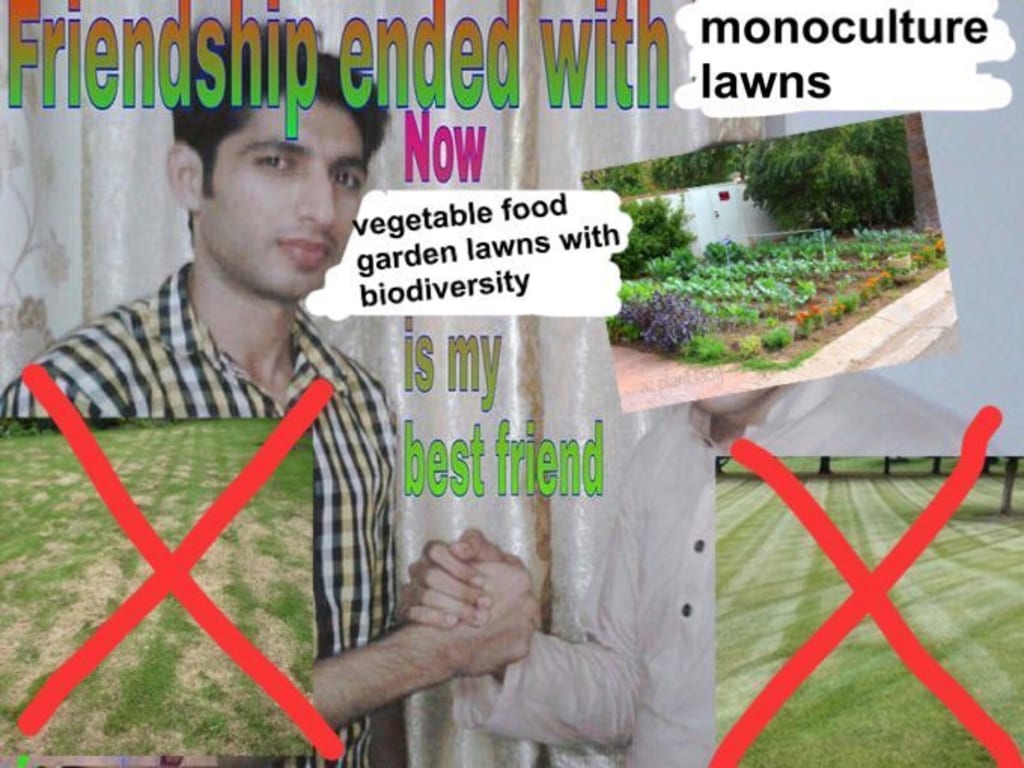Radical Grass-tivism: Reshaping your Home’s Plant Composition for a Better Future
The Monoculture Lawn is Outdated - How You Can Benefit From Replacing it With Native Plants

Have you ever stopped to think about your lawn? It's more than just a patch of green – it's a vital part of your local ecosystem. The traditional approach of cultivating manicured lawns with non-native grass is a centuries-old tradition, but it's time to reevaluate its impact on the environment.
Discover why traditional lawns are outdated, why you can benefit from making the transition to a lawn full of native plants, and how you can successfully make the change sustainably:
Why Traditional Grass Lawns Are No Longer Serving Us
Many pro-lawn advocates compare traditional grass to asphalt, wood, and concrete, citing that traditional grass is better at trapping carbon dioxide and cleaning the air than no plants at all. The upkeep required to keep traditional grass lawns looking neat and orderly, however, still has a higher carbon footprint than native plant gardens and landscapes. The main culprit is the machinery used to tidy these sorts of lawns, which is needed weekly or bi-weekly, depending on the species you’re harboring.
But it isn't solely gas-powered mowers and edgers, grass lawns also require the use of chemical additives to keep it thriving, more than native plants often do. Pesticides and herbicides especially can pollute the local ecosystem and harm native animals. According to the Illinois EPA, “Everything applied to your yard has the potential to contaminate ground and surface waters”. With looming water scarcity, it’s more important than ever to curb our effect on water pollution.
If the pollution of water wasn’t enough, traditional non-native grass lawns also use up much more water than native plants do. Even if your region is generally wealthy in water resources, all that water use will still cost you a significant amount of money in the long run.
And, when grasses escape past the boundary line of your yard, they essentially enter into competition with native wild plants. This can put a lot of stress on your local habitat, altering soil nutrients, increasing wildfire risk, and stressing local water resources. When the invasives triumph over native plants, it harms native biodiversity immensely, causing native displacement and the loss of biodiversity in your local region.
Why Replacing Your Lawns With Native Plants is Better for You and The Environment
Native grasses and other plants often commonly have root systems adapted better for the natural soils in your area, making it better for combating soil erosion and better for your soil’s water retention, depending on your choice of plant. Making the transition can have a hugely positive impact on the health of your land, which is especially handy if you’re considering taking up gardening.
Adding native plants to your lawn can also help local insects and other small creatures. Local pollinators and small creatures are adapted to recognize native plants, making native plants four times more attractive to them than non-native species that fill the same niche. Transitioning to native plants can result in happier, healthier wild animals in your region - plus you get the added bonus of getting to see more cute critters about your property. That sounds like a win-win to me, personally.
Native grass lawns will also result in less total long-term work for your yard - that means less money, too! Once the plants are established and happy, they’re already adapted to fit your local climate, meaning less worrying about watering and sun exposure, and more enjoying the beauty of your lawn. In some cases, you may not even need to worry about mowing, applying fertilizers, and other maintenance activities!
On top of all these benefits, native lawns simply look gorgeous. Biodiversity, blooming flowers, and happy insects make for quite a lovely sight.
If you’re more keen on practicality than native biodiversity, using your lawn to garden crops is a potential alternative to explore, that still has a much more positive impact on the environment than traditional grass lawns. According to Schultes Greenhouse, garden plants, compared to lawns, “act as highly effective air cleaners, absorbing carbon dioxide, plus many air pollutants, while releasing clean oxygen and fragrance”. Even though it may not have quite as a massive positive impact as going fully native, this transition is absolutely a valid improvement.
Why There’s So Much Pushback on Native Grass Lawns
Pushback on the replacement of lawn grass with native grass is rife, after hundreds of years of culture presenting the lawn as a desirable aspect of a wealthy home. There’s evidence that manicured, ornamental decor grass lawns have been around since the 15th century. At this point, the idea is essentially a part of the collective human psyche. Tradition and culture are most certainly contributors to the lack of change in this industry. The sentiment persists and, anecdotally, I’ve seen many folks raise their hackles at the notion of this change for this very reason. However, it's important to remember that just because some action has been done a certain way for generations, does not mean it is the best way to do it.
In addition, even for the most forward-thinking and progressive folks, it can take a significant amount of effort, time, and money to establish some native grasses. Not everyone is fortunate enough to have the time or resources to make such a change. It’s at this point I must point out to the reader that economic disparity and strife make it more difficult to make changes that aid the planet, which is the fault of the extant economic system and not the individual. Do not fault those who cannot afford to make such changes in their life. Should you be able to afford the change, as I mentioned above, it will end up costing less money in the long term to make the transition.
There is also, of course, the case of appearance. Some people prefer the aesthetic of a neat, orderly lawn and classic lawn grass has been specifically selectively bred for that preference for hundreds of years. Some native plants don’t grow as thickly and neatly as the grasses we’ve farmed because of that. Some others, however, grow in more lovely ways, with much more aesthetic interest than a well-manicured turfgrass could ever dream of.
There’s also the matter of local regulations. Sometimes, especially if you live in a home governed by an HOA, there are strict rules against certain “wild” or “unkempt” appearances of lawns. The reasons aren’t always aesthetically-led, either. In fire-prone regions, there are genuine issues with some native plants being more flammable, thus causing greater danger for homeowners and their neighbors. But not all native plants are alike. With the right bit of investigation, you will be able to find native plants that work for your local regulations, your safety, for you, and your local environment.
How You Can Successfully and Sustainably Make Your Lawn a Native Haven
The first step is to talk to a local landscaper, plant expert, or gardener. They’ll likely be able to point you in the right direction, more so than this author can. People with experience with native plants in your location can be an excellent resource for understanding how you can best make positive changes toward planting the native lawn of your dreams. As an alternative, do some metaphorical digging to find local gardening clubs, co-op gardens, and local environmental activism groups. These folks can also be amazing resources in beginning your journey toward a native garden.
Once you have an idea of your goal, look into the local ecology of your region. Which invasive plants are ecologists trying to cull? Which plants are endangered or vulnerable? The more you know about your local wildlife, the better an informed decision you can make. One of the best ways to find out this information is, of course, turning to the internet, which you already have a head start on if you’re reading this paragraph. The US Forest Service has some great information on alternative plants and how to grow them for starters.
It’s imperative that before you begin shoveling, you check with your HOA and local zoning laws before making the change. Swapping over to native lawns will take effort, and that would all be for naught if you’ve decided to plant an herb that your neighborhood unanimously detests. Check and double-check before engaging in renovations like these.
Bonus Pro Tip: Check for incentives from your state and local governments. Some states actually rebate homeowners who modify their lawns to contain native species. California, for example, has a huge program that encourages homeowners to make the switch to native lawns.
–
The facts are clear: traditional grass lawns are no longer in our best interest. Native lawns have so much more to offer, saving us money and helping the environment, too! If you have the means to make a positive change to your land, you have the potential to create a haven for your neighborhood’s local habitat. With modifications like these, you can directly and acutely impact the world around you for the positive.
Interested in switching to a native grass in your lawn? On the National Wildlife Federation website, you can find suggestions based on your Zip Code on the Native Plants Finder page. You can also check out this article by Rewilding Magazine for tips and tricks on making your transition easier. Happy planting!
About the Creator
Olivia L. Dobbs
Science Enthusiast, Naturalist, Dreamer, Nerd.
I crosspost my Medium articles here :)
You can find my main account on Medium: https://medium.com/@oliviadobbs13
Check out my science! -> bit.ly/DobbsEtAl






Comments
There are no comments for this story
Be the first to respond and start the conversation.